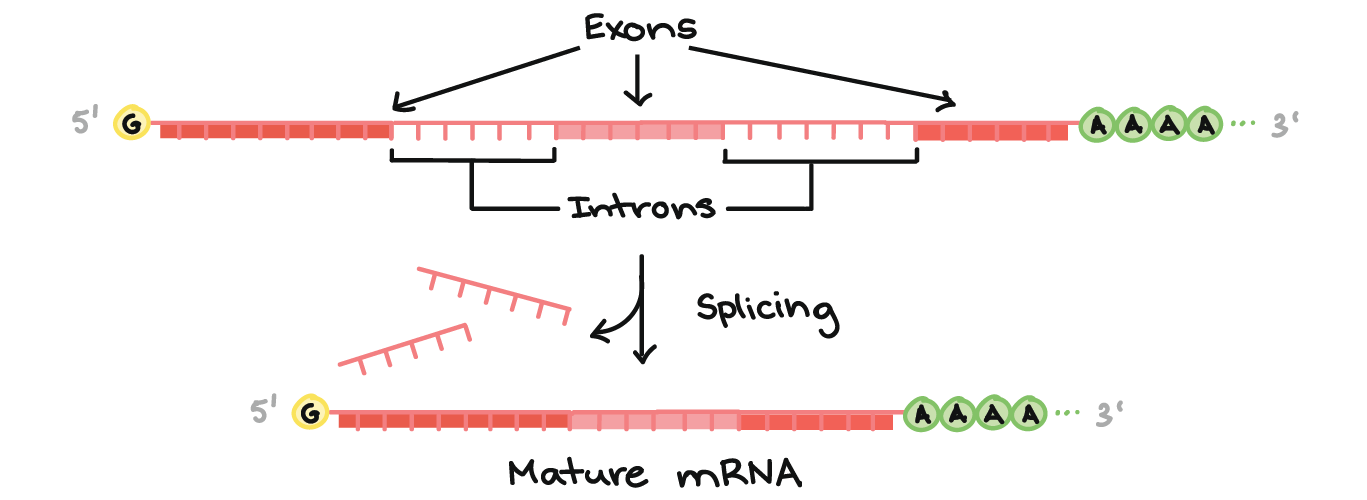The central dogma
There is something very important in molecular biology called the central dogma. It is the information flow from our genes contained in DNA to mRNA through transcription and to proteins through translation. This has been considered the central dogma since every organism based on DNA uses this flow. However, we’ve already seen in What’s in your genome? that an enzime called reverse transcriptase can do the opposite, generate DNA from RNA, which made things a bit fuzzy; but let’s not get derailed here.
RNA alternative splicing
Something very interesting happens between the RNA stage and the protein stage, called RNA splicing. Druing this process the mRNA is processed before transcription and through which bits and pieces are cut and glued together for making the final genic product that will be translated to protein. Check out this scheme:

Splicing is an essential process that every mRNA goes through, especially in higher vetebrates where introns (the parts not coding for proteins, but mostly for regulation) are very common.
Optimizing the space in our DNA
The fact that through alternative splicing we can have different variants of proteins from the same gene, is a clever stocking idea to have more information in a contained space in the DNA. If you have different RNAs from a single gene, you don’t have to have a different gene for every protein so you save space in your chromosomes. Having RNA splicing allow for many combination on a second level.
So with alternative splicing we can have different RNA that will produce different proteins. What’s amazing about this is exactly how many variants we can have. Most genes have only few variants but some of them are strikingly diverse! The example I want to give is the Dscam gene. It’s a human gene, but it’s been deeply characterized in Drosophila melanogaster, the fruit fly; so for the sake of my purposes we will just focus on the fly homologous gene instead of the human version.
Dscam alternative splicing can produce a huge amount of isoforms
Dscam has 115 exons that can be joined together in different combinations. Through alternative splicing the fruit fly can produce up to 38,016 different proteins!!! This is an unbelievable number of variants for a single gene!!! But why would you need so many isoforms (variants) of a gene? Generally, isoforms like these ones, that come from the same gene, have similar functions, because it’s very hard to create drastically different proteins with the same genetic sequence.
What do all these isoforms do?
Do you remember neurons from biology class?? They are the typical cells making up our nervous system. Neurons create amazing networks connecting their branches (dendrites and axons) to other neurons and other cells. But every connection has a purpose, no connection is randomly assigned. But during the development of the brain, how do the “baby” neurons know where to go and to connect? Every branch leaves the body of the cell looking for its target between millions of destinations. Branches follow gradients of molecules that are produced by their target. It is like a dog following an odor, he’s led by it to the source of the smell. But branches don’t only have to find their target but they also have to avoid each other and avoid wrong connections. Imagine the complexity and the chaos: a growing branch that’s traveling toward its target has to avoid any collision with other branches, especially the ones from the same cell. In fact, if branches from the same cells would connect, they would create a short circuit and it would probably highly compromise neuronal function.
And we come back to our Dscam gene. Every neuron produces a different pattern of variants of the gene and the neurons follow a simple rule: cells with similar patterns never connect. Simple right? Having many thousands of variations of the protein allow branches from neuronal cells to avoid short circuits and wrong connections, pretty clever I’d say! This is a great example of how such a simple rule and implementation leads to huge combinatory numbers that eventually bring great advantages for the whole system!
The complexity we can observe at the molecular level is really impressive, simple rules for amazingly elaborated effects make up nature and the world. It’s all up to us being smart enough to understand them. And while we figure them out, let me tell you another story..

Leave a comment